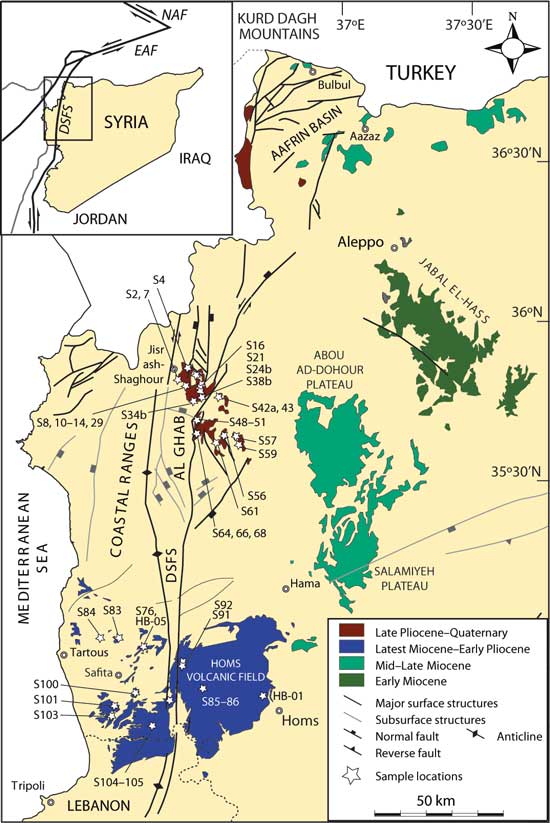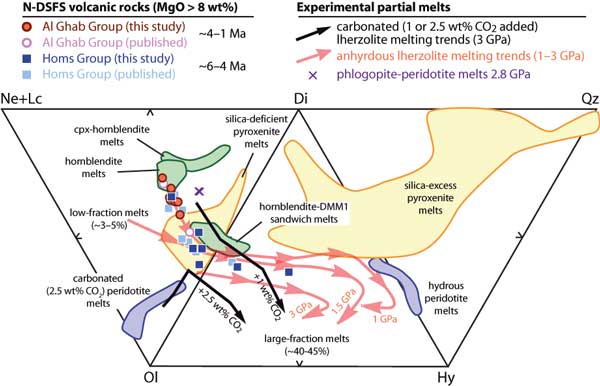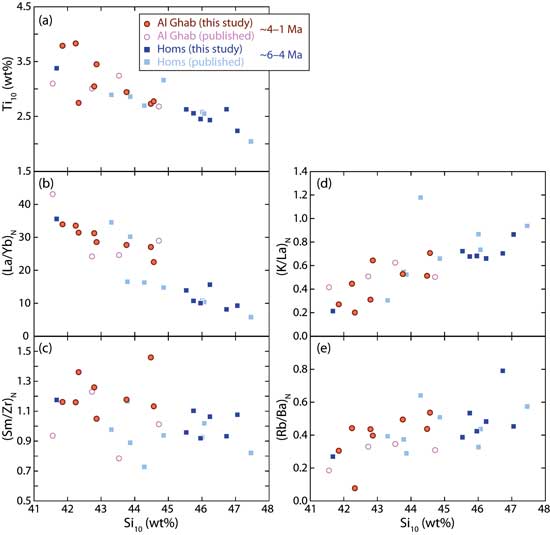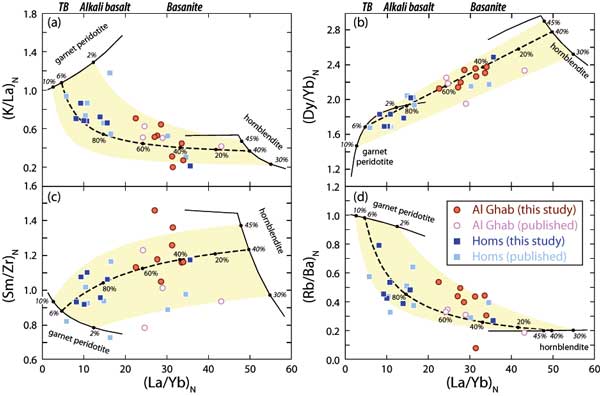 |
The
significance of metasomatic amphibole veins
in the genesis of the intraplate lavas in NW
Syria |
George S.-K. Ma1, John Malpas1,
Costas Xenophontos1 & Gavin H.-N. Chan2
1Department of Earth
Sciences, The University of Hong Kong, Pokfulam Road,
Hong Kong, georgema@graduate.hku.hk ; jgmalpas@hku.hk ; cosxen@spidernet.com.cy
2Department of Earth
Sciences, Oxford University, Parks Road, Oxford,
OX1 3PR, UK, gavin.chan@earth.ox.ac.uk
This webpage is a summary of: Ma,
G. S.-K., Malpas, J., Xenophontos, C. & Chan,
G. H.-N. (2011). Petrogenesis of latest Miocene–Quaternary
continental intraplate volcanism along the northern
Dead Sea Fault System (Al Ghab–Homs Volcanic
Field), western Syria: evidence for lithosphere–asthenosphere
interaction. Journal
of Petrology, 52, 401-430.
Introduction
Basalts from scattered
Neogene intraplate volcanic fields along the northern
Dead Sea Fault System in northwestern Syria (termed
N-DSFS lavas; Figure 1) are similar to many volcanic
rocks of continental intraplate settings worldwide — low
melt volume, ranging in composition from basanitic
to tholeiitic (transitional), no clear age progression,
and no associated domal uplift. No plausible relationship
with a mantle plume can be determined. We have
assembled geochemical data of this region previously
published by various authors (Abdel-Rahman & Nassar,
2004; Lustrino & Sharkov, 2006; Krienitz
et al., 2009) and those of our own, and consider
the origin of these basalts using knowledge gained
from recent partial melting experiments by others
(e.g., Pilet et al., 2008).

Figure 1. Distribution
of Cenozoic volcanic rocks in northwestern Syria and
northern Lebanon, with major structural features redrawn
after Brew et
al. (2001). EAF, East Anatolian Fault; NAF, North
Anatolian Fault; DSFS, Dead Sea Fault System.
The volcanic rocks we study erupted around Homs (~6–4
Ma) and in the northern Al Ghab depression (4–1
Ma), and are associated with a shield volcano and numerous
small cinder cones respectively.
Geochemical signatures of the involvement
of amphibole in the source region
Comparing the most primitive N-DSFS lavas (8.1-11.7
wt% MgO on anhydrous basis) with isobaric experimental
partial melts (Figure 2) suggests that the lavas have
an intimate relationship with amphibole-rich lithologies
during partial melting.

Figure 2. CIPW normative diopside,
olivine, hypersthene, nepheline+leucite and quartz
variations in the relatively primitive, least crustally
contaminated N-DSFS samples (MgO ≥ 8 wt%, Ce/Pb ≥ 21
and Ba/Nb ≤ 10). Also
shown are the melt compositions in a range of partial
melting experiments on various sources, including:
phlogopite-bearing peridotite, carbonated peridotite
(KLB-1), hydrous peridotite (KLB-1), silica-deficient
pyroxenite (MIX1G), silica-excess (G2 and JB-1) pyroxenite,
hornblendite (AG4), clinopyroxene-hornblendite (AG7)
and sandwiched hornblendite–depleted peridotite
(DMM1) which are referenced in detail in Ma
et al. (2011). Arrows show partial melting trends,
at different pressures, for anhydrous peridotite (KLB-1
and similar compositions) based on the compilation
of Thompson et al. (2005), and trends
for CO2-bearing peridotite (Dasgupta et
al., 2007).
In general, the compositions of the N-DSFS lavas lie
close to the trends of anhydrous partial melts generated
by progressive melting of peridotite at 1 and 1.5 GPa,
with the majority of the lavas being Si-undersaturated
and falling on the (Ne+Lc)–Di–Ol plane.
What interested us most is that the Si-undersaturated
lavas are “deflected” towards the compositional
field defined by melts of hornblendite, in which some
indeed fall.
Other potential mantle lithologies/components do not
seem to have a significant role in the genesis of the
N-DSFS lavas:
- Carbonated peridotite:
in the experiments of Dasgupta et
al.
(2007) such partial melts are composed of 4–25
wt% dissolved CO2 and tend to be very
Ca-rich and Si-, Ti-, Fe- and alkali (especially
K)-poor, characteristics that are not observed
in the N-DSFS magmas;
- Anhydrous fertile
lherzolite:
compared to anhydrous lherzolite melts, OIB magmas
are more enriched in Fe and Ti, but too depleted
in Si and Al, which may be better explained by
incorporation of an additional mafic component
in the source (e.g.,
Prytulak & Elliott, 2007 and references
therein);
- Carbonated Si-deficient
eclogite:
this lithology tends to generate high FeO, CaO
and CaO/Al2O3 that do
not fit the compositional spectrum of OIB.
The K2O contents of the melts that have been
generated in the experiments are also very low,
in contrast to the generally high alkali contents
of Si-undersaturated basalts;
- Phlogopite- and
amphibole-bearing peridotite: The
most primitive N-DSFS magmas (MgO > 8 wt%)
exhibit an appreciable range of SiO2 contents
from ~41 to 48 wt% (from basanites to alkali basalts
transitional to tholeiitic basalts). This range
does not change very much after fractionation correction
(Figure 3). Although the depth and, to a lesser
extent, the degree of partial melting are known
to exert some control on the SiO2 contents
of magmas (e.g.,
Hirose & Kushiro, 1993; Kushiro,
1996; Walter, 1998; Wasylenki et al.,
2003), low-Si magmas have never been successfully
produced in partial melting experiments of anhydrous
peridotite (S. Pilet, personal communication).
Experimental partial melts of anhydrous peridotite
are mostly in the range 45–54 wt% SiO2 (e.g.,
Hirose & Kushiro,
1993; Kushiro, 1996; Walter,
1998; Wasylenki
et al., 2003). The presence of phlogopite
(deductively also amphibole) in a peridotitic
source does not seem to lower the SiO2 contents
of the melts either, as evidenced by the experiments
of Mengel & Green (1989).
It is clear that whereas the N-DSFS alkali and
tholeiitic basalts can be products of peridotite
melting, the basanites cannot.

Figure 3. (a) Ti10,
(b) (La/Yb)N, (c) (Sm/Zr)N, (d) (K/La)N and (e) (Rb/Ba)N vs Si10 for the relatively
primitive N-DSFS samples. Ti10 and Si10 are
the estimated concentrations of TiO2 and
SiO2 respectively at 10
wt% MgO after correction for crystal fractionation.
Subscript N denotes normalization by primitive mantle
values.
Together, these facts suggest that hornblendite or
similar metasomatic amphibole-rich veins are by far
the most plausible components in the source for the
genesis of these Si-undersaturated magmas.
It is found that within the range
of Si10, the Ti10,
La/Yb, K/La (K-anomaly), Rb/Ba (Rb-anomaly) and, to
a lesser extent, Sm/Zr (Zr-anomaly) of the N-DSFS lavas
vary systematically (Figure 3). These correlations
are explained by mixing or interaction between at least
two source components — a metasomatic component
in the form of an amphibole-rich lithology (high in
Ti, La/Yb and Sm/Zr, and low in Si, Rb/Ba and K/La)
and a peridotitic component. This hypothesis is tested
by calculating the expected melt compositions derived
by melting a hornblendite and a perditotite. The modelling
results reveal that the compositions of nearly all
of the N-DSFS lavas lie between calculated partial
melting curves of a garnet-bearing hornblendite and
a garnet-bearing peridotite, and suggest that the N-DSFS
lavas can be generated by mixing (or other kinds of
interaction) between melts generated by the two source
lithologies (Figure 4).

Figure 4. Primitive mantle-normalized
(a) (K/La)N, (b) (Dy/Yb)N, (c) (Sm/Zr)N and (d) (Rb/Ba)N vs (La/Yb)N for the relatively primitive, least crustally
contaminated N-DSFS lavas. The continuous curves show
non-modal batch melting models for a lherzolite (with
a primitive mantle composition) and a hornblendite
metasomatic vein (AG4 of Pilet et al., 2008)
as starting materials, from 1 to 16.8% and from 25
to 60% melting respectively. The kink in the metasomatic
vein melting curve results from complete consumption
of amphibole at 47.5% melting; beyond this point, melting
mode of the residual ‘‘pyroxenite’’ vein
is assumed to be modal for simplicity. It should be
noted that most basalt samples fall in the yellow-shaded
fields, which define the possible melt compositions
from 0 to 100% mixing of small-degree (F =
2–10%) lherzolite melts and large-degree (F =
30–45%) metasomatic vein melts. For clarity in
the diagram, the degrees of melting and mixing are
not always displayed but the latter can be evaluated
from the representative mixing curve (dashed) between
a 6% lherzolite melt and a 40% vein melt (numbers along
the dashed curve denote the proportion of lherzolite
melt in the hybrid melt). Italic numbers along the
continuous curves are the degrees of partial melting.
Despite some scatter, samples of the Al Ghab group
(mainly basanites) are characterized by higher (La/Yb)N,
(Dy/Yb)N and (Sm/Zr)N, and lower (K/La)N and (Rb/Ba)N,
suggesting greater influence of metasomatic veins during
their petrogenesis. Positions of the terms basanite,
alkali basalt (AB) and tholeiitic basalt (TB) along
the top of (a) and (b) denote the approximate (La/Yb)N ranges of each type. Other parameters are given in
Table 6 of Ma et
al. (2011). F, degree of partial
melting.
Indeed, when the Si10,
which is a proxy of the metasomatic component of the
lavas, are compared with the isotopic composition,
it appears that the elemental correlations observed
in Figures 3 and 4 cannot simply be a two-component
binary mixing — three
components are needed to explain the Si10–isotope
variations, and these are components interpreted to
represent the metasomatic veins, lithospheric wall-rock
peridotite which hosts the metasomatic veins and asthenospheric
peridotite mantle (for details of derivation see Ma
et al.,
2011).
Geodynamic considerations
There is
increasing dominance of basanites over alkali (and
tholeiitic) basalts from south (Homs; latest Miocene–Early
Pliocene) to north (Al Ghab; Late Pliocene–Quaternary)
over time, and this dominance is accompanied by a significant
decrease in the overall volume of magma erupted (Figure
1). These characteristics may therefore be more consistent
with a diminished thermal perturbation (a rifting
model is excluded considering the absence of large-scale
lithosphere extension in the region) below the Al
Ghab volcanic field during Late Pliocene to Quaternary
times. These considerations lead to the following
model, in which a lithosphere previously metasomatized
to contain amphibole-rich veins is involved.
In Syria, the observation that the northward migration
of the volcanism was contemporaneous with the propagation
of the DSFS and accompanied by an increase in Si-undersaturation
in magma chemistry and a decrease in magma volume appears
to be consistent with a channelled flow model. When
asthenospheric upwelling mantle material (small-scale
upper mantle diapirs or passive upwelling as a result
of slab break-off beneath eastern Anatolia) was first
emplaced beneath the Homs region in the latest Miocene,
it was at its hottest and itself melted adiabatically
to contribute rising magmas (this give rise to the
asthenospheric mantle component). Heat advection and
conduction caused the lithosphere to melt; interactions
involving wall-rock assimilation (metasomatic veins
and lithospheric peridotite assimilated by the ascending,
hot asthenospheric melts) or melt hybridization (melts
formed separately at first and mixed during ascent
through the crust) produced a spectrum of magmas from
basanite to tholeiitic basalt. Northward propagation
of the DSFS diverted the partially molten asthenospheric
material, which might have been continuously rising
beneath the Homs region, to the Al Ghab region in the
Late Pliocene. This material was probably cooler than
it had been, and was unable to penetrate the Al Ghab
lithosphere. The amount of thermal perturbation by
conduction was probably just sufficient to trigger
melting of the lowest solidus materials within the
base of the lithosphere, the amphibole-rich metasomatic
veins, which interacted with their wall-rock lithospheric
peridotite to produce a spectrum of basanites and alkali
basalts.
Conclusions
Among the least contaminated N-DSFS
lavas, the Si-undersaturated lavas (basanites) are
characterized by low SiO2, K/La
and Rb/Ba, and high TiO2, Sm/Zr and Dy/Yb. These features
are consistent with magma derivation largely from garnet-bearing
hornblendite metasomatic veins, plus modest interactions
with the surrounding wall-rock peridotite within the
lithospheric mantle. The increasing extent of interaction
and hybridization of such veins or their melted products
with the wall-rock peridotite and rising asthenospheric
magmas generated the more Si-rich N-DSFS lavas (alkali
and tholeiitic basalts).
The observation that the younger Al Ghab group is
dominated by basanites and the older Homs group by
alkali and tholeiitic basalts reveals a significant
control on magma compositions by hornblendite metasomatic
veins and peridotitic mantle, respectively, during
magma genesis. The temporal, spatial and compositional
variations of the N-DSFS basalts can be explained as
a consequence of the northward propagation of the N-DSFS
during the Late Cenozoic and consequent channelling
at the base of the lithosphere of upwelling asthenospheric
mantle from the Homs region.
Post-publication notes
The latest
S-velocity studies (after the publication of Ma et
al.,
2011) provide independent
geophysical evidence for widespread low-velocity
seismic structures, which can be related to thermal
anomalies or melt/volatile-rich zones, beneath much
of Arabia and east Africa. Chang & Van
der Lee (2011) demonstrate three independent
mantle diapirs, beneath Jordan, Kenya and Afar, extending
down to at least mid mantle depths (~1400 km). According
to their model, the volcanism in NW Syria that we
have studied may be associated with a deeply-rooted
(lower mantle), larger low-velocity structure (diapir)
beneath Jordan, Israel and southern Syria, which
becomes flattened above ~400 km and flows northwards
(and also southwards) to eastern Anatolia.
References
-
Abdel-Rahman,
A.-F. M. & Nassar, P. E. (2004).
Cenozoic volcanism in the Middle East: petrogenesis
of alkali basalts from northern Lebanon. Geological
Magazine, 141, 545-563.
-
Brew,
G., Barazangi, M., Al-Maleh, A. K. & Sawaf,
T. (2001). Tectonic and geologic evolution of Syria. GeoArabia, 6,
573-616.
-
Chang, S.-J. & Van der Lee,
S. (2011). Mantle plumes and associated flow beneath
Arabia and East Africa. Earth
and Planetary Science Letters, 302,
448-454.
-
Dasgupta, R., Hirschmann, M.
M. & Smith,
N. D. (2007). Partial melting experiments of peridotite
CO2 at 3 GPa and genesis of alkalic ocean island
basalts. Journal
of Petrology, 48, 2093-2124.
-
Hirose,
K. & Kushiro, I. (1993). Partial melting
of dry peridotites at high-pressures: determination
of compositions of melts segregated from peridotite
using aggregates of diamond. Earth and Planetary
Science Letters, 114, 477-489.
-
Krienitz,
M.-S., Haase, K. M., Mezger, K., van den Bogaard,
P., Thiemann, V. & Shaikh-Mashail, M.
A. (2009). Tectonic events, continental intraplate
volcanism, and mantle plume activity in northern
Arabia: constraints from geochemistry and Ar-Ar
dating of Syrian lavas. Geochemistry, Geophysics, Geosystems, 10,
doi:10.1029/2008GC002254.
-
Kushiro, I. (1996). Partial
melting of a fertile peridotite at high pressure:
an experimental study using aggregates of diamond.
In: Basu, A. & Hart, S. (eds.) Earth
processes: reading the isotope code. Geophysical
Monograph 95: American Geophysical
Union.
-
Lustrino, M. & Sharkov,
E. (2006). Neogene volcanic activity of western
Syria and its relationship with Arabian plate kinematics. Journal of Geodynamics, 42,
115-139.
-
-
Mengel, K. & Green, D. H.
(1989). Stability of amphibole and phlogopite in
metasomatized peridotite under water-saturated
and water-undersaturated conditions. In: Ross,
J. (ed.) Kimberlites and related rocks:
Proceedings of the Fourth International Kimberlite
Conference. Perth: Geological Society of Australia,
571-581.
-
Pilet, S., Baker, M. B. & Stolper,
E. M. (2008). Metasomatized lithosphere and the
origin of alkaline lavas. Science, 320,
916-919.
-
Prytulak, J. & Elliott,
T. (2007). TiO2 enrichment in ocean island basalts. Earth and Planetary
Science Letters, 263, 388-403.
-
Thompson,
R. N., Ottley, C. J., Smith, P. M., Pearson, D.
G., Dickin, A. P., Morrison, M. A., Leat, P. T. & Gibson,
S. A. (2005). Source of the Quaternary alkalic
basalts, picrites and basanites of the Potrillo
Volcanic Field, New Mexico, USA: lithosphere or
convecting mantle? Journal
of Petrology, 46, 1603-1643.
-
Walter,
M. J. (1998). Melting of garnet peridotite and the
origin of komatiite and depleted lithosphere. Journal
of Petrology, 39, 29-60.
-
Wasylenki,
L. E., Baker, M. B., Kent, A. J. R. & Stolper,
E. M. (2003). Near-solidus melting of the shallow
upper mantle: partial melting experiments on depleted
peridotite. Journal
of Petrology, 44, 1163-1191.
last updated 17th
March, 2011 |
